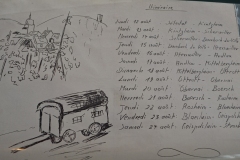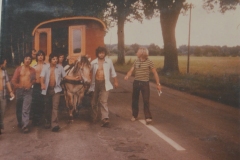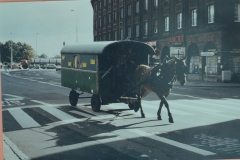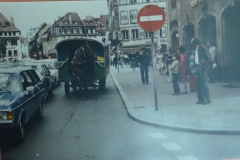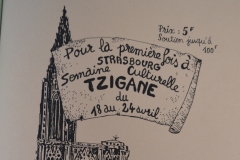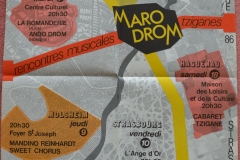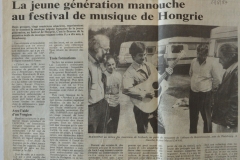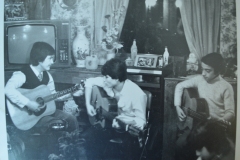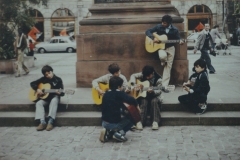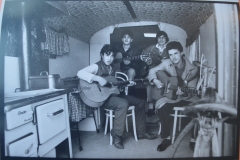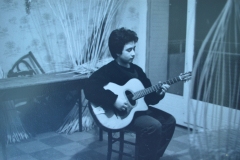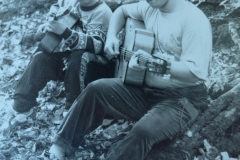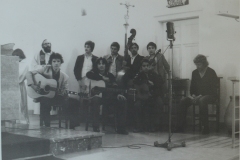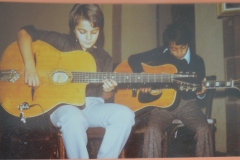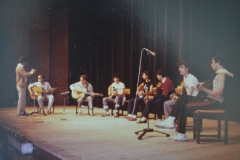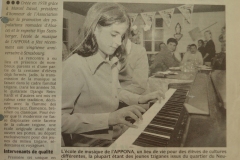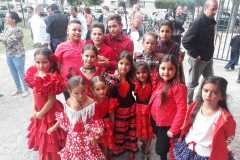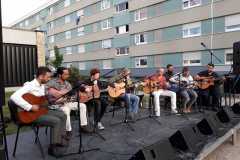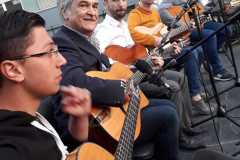Media: Chapter 2
Chapter 2, “Cultural Activism’s Living Legacies,” centers on the life and afterlife of the nonprofit organization L’Association pour la Promotion des Populations d’Origine Nomade d’Alsace (APPONA) to show how jazz manouche emerged as a resource for pro-Manouche cultural activism. APPONA was founded in the 1970s out of serious concerns over violent racism against Manouches as well as anxiety about Manouche cultural loss. The organization subsequently built the economy of public Manouche musical production in Alsace as a means to combat racism and to integrate Manouches into the workforce. Its leaders promoted music professionalization as a technique of entrepreneurship while valorizing aural pedagogies as emblematic of Manouche alterity. By examining how these aims evolved over time and manifest in Alsace today, I show that ambivalent essentialism necessarily underlies cultural activism for French Manouches. In its growth, demise, and living legacy, APPONA exemplifies the fundamental contradiction of cultural citizenship in France: how to construct ethnoracial singularity as an asset while working toward inclusion in an assimilationist nation.
Image 2.0: cover of the 1997 APPONA Rapport moral (President’s Report). The cover illustration (by May Angeli) depicts the earth encircled by old-fashioned roulottes and modern automobile-towed caravans. Note the guitar in the center of the APPONA logo. Source: Archives de la Ville et de l’Eurométropole de Strasbourg, 168 Z.
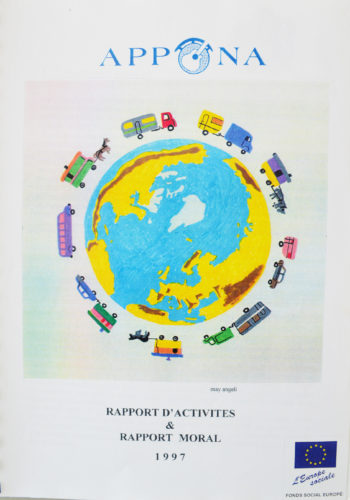
Le C(h)œur des femmes
(pp. 64-65, 68, 90-92, 96-97)
Videos of le C(h)œur des femmes in concert
The following two videos are from a C(h)œur des femmes concert at the Salle de la Bourse in Strasbourg on 13 December 2013. The ensemble is directed by Anne Huber.
Video 2.1: "Blue Moon" (written by Richard Rodgers and Lorenz Hart). Vocal solo: Lisha; guitar solo: Dino Mehrstein. Video by Siv B. Lie.
Video 2.2: "Mer Djina" (written by Mandino Reinhardt). Vocal solo: Olivia; guitar solo: Mandino Reinhardt. Video by Siv B. Lie.
Audio examples
Audio example 2.1: "Digo O Dives"
Performed by the C(h)œur des femmes at the Espace Django, Strasbourg, 23 June 2014. Music and lyrics by Mandino Reinhardt. Vocal solo: Debby; guitar solo: Mandino Reinhardt. Recording by Siv B. Lie.
Audio example 2.2: "Plus je t'embrasse"
Performed by the C(h)œur des femmes at the Espace Django, Strasbourg, 23 June 2014. Music by Ben Ryan (as "Heart of My Heart"), lyrics by Max François. Vocal solos: Ringo Weiss and Géranea; guitar solo: Mandino Reinhardt. Recording by Siv B. Lie.
Video 2.3: Saintes-Maries-de-la-Mer Performance
"Mer Djina," by Mandino Reinhardt, performed at a celebration of the life of Pisla Helmstetter in Saintes-Maries-de-la-Mer, 24 May 2014. Vocal solo: Géranea; guitar solo: Engé Helmstetter. Video by Hayet Berkioui.
More photos and text (in French) about the C(h)œur des femmes can be found on its KissKissBankBank crowdfunding page, launched for the Saintes-Maries-de-la-Mer trip.
A Manouche “Brand Image” (pp. 73-76)
Photo gallery 2.1: APPONA programming, 1970s-1980s
Click on the images below to enlarge. Click "image descriptions" under the gallery for more information.
- 2.1.1 - Itinerary for Le Voyage en roulotte, 1974 (see pp. 52, 74). Source: Archives de la Ville et de l’Eurométropole de Strasbourg, 168 Z.
- 2.1.2 - Le Voyage en roulotte in Sélestat, 1974 (see pp. 52, 74). Source: Archives de la Ville et de l’Eurométropole de Strasbourg, 168 Z.
- 2.1.3 - Le Voyage en roulotte, 1974 (see pp. 52, 74). Source: Archives de la Ville et de l’Eurométropole de Strasbourg, 168 Z.
- 2.1.4 - Le Voyage en roulotte, 1974 (see pp. 52, 74). Source: Archives de la Ville et de l’Eurométropole de Strasbourg, 168 Z.
- 2.1.5 - Advertisement for the Semaine Culturelle Tzigane, 1977 (see pp. 53, 75). Source: private APPONA archive, courtesy of Stella Funaro.
- 2.1.6 - Poster for 1986 “Maro Drom: Tzigane Musical Encounters” concert series. This multi-sited series included local acts as well as Ando Drom from Hungary and La Romanderie from Germany. It continued the spirit of Le Voyage en roulotte and the Tsigane Cultural Week. Source: Archives de la Ville et de l’Eurométropole de Strasbourg, 168 Z.
- 2.1.7 - Newspaper article on music school trip to Hungary, 1987 (see pp. 75-76). The photo includes Marcel Daval (far left) and Mandino Reinhardt (center, with guitar). English translation of title: “Tsiganes in Alsace: Two musical ensembles invited to Hungary.” Author: Marie Brassart-Goerg. Source: Archives de la Ville et de l’Eurométropole de Strasbourg, 168 Z.
Building Cohesion and Pride (pp. 76-79)
Photo gallery 2.2: Students of the APPONA music school, 1970s-1980s
Click on the images below to enlarge. Click "image descriptions" under the gallery for more information.
- 2.2.1 - Mandino Reinhardt and students. Source: private APPONA archive, courtesy of Stella Funaro.
- 2.2.2 - Guitar students in central Strasbourg. Source: private APPONA archive, courtesy of Stella Funaro.
- 2.2.3 - Students posing in caravan. Source: private APPONA archive, courtesy of Stella Funaro.
- 2.2.4 - Dino Mehrstein (surrounded by woven baskets-in-progress). Source: private APPONA archive, courtesy of Stella Funaro.
- 2.2.5 - Djendi Kampfer and Dino Mehrstein. Source: private APPONA archive, courtesy of Stella Funaro.
- 2.2.6 - Recording session. Source: private APPONA archive, courtesy of Stella Funaro.
- 2.2.7 - Francky Reinhardt and Chengele Hoffmann. Source: private APPONA archive, courtesy of Stella Funaro.
- 2.2.8 - Mandino Reinhardt leading students onstage. Source: private APPONA archive, courtesy of Stella Funaro.
- 2.2.9 - Newspaper feature on the music school's 20th anniversary. Source: private APPONA archive, courtesy of Stella Funaro.
From Students to Professionals (pp. 81-85)
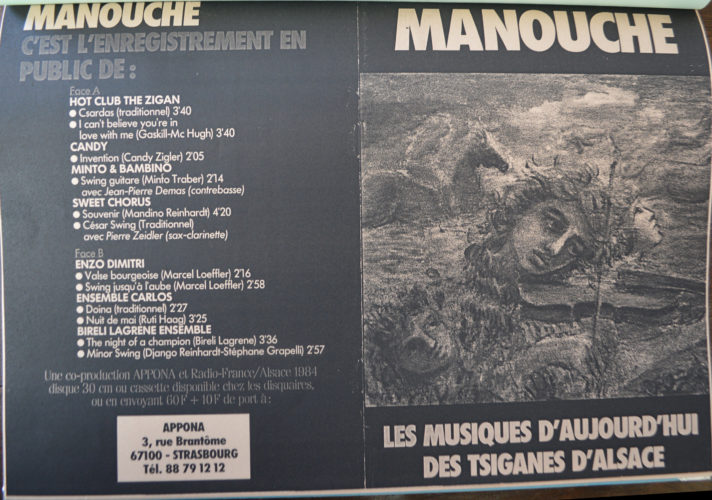
Figure 1 (p. 83): Advertisement for Manouche: Les musiques d’aujourd’hui des Tsiganes d’Alsace (1984). Image courtesy of Stella Funaro. Illustration by Torino Zigler.
Decline and Afterlife (pp. 85-88)
Organization websites
- APPONA 68 (p. 86)
- AVA Habitat et Nomadisme (p. 86)
- JEEP (pp. 86-87)
- Lupovino (pp. 87-88)
Video 2.4: Lupovino
The following short news feature, "Lupo-Vino: The Tsigane Women of the Polygone (Strasbourg)," was produced in 2010.
ENGLISH TRANSLATION
0:00: ANNOUNCER: These Gens du voyage aren’t really [Gens du voyage] anymore. In 1973 they made the choice to settle on the site of the Polygone in Strasbourg. The living conditions are sometimes unsanitary, so to improve the everyday life of the community, the Manouche women of the camp created the association Lupovino in 1995.
00:18: HAYET BERKIOUI: Right from the start, the [employees worked from spaces] just behind, next to the Manouche settlements. And now, for a few years, we’ve worked out of the old school for Voyageurs. [Author’s note: “Voyageurs” is a term for Gens du voyage; the relatively new space for Lupovino is situated across the street from the Manouche settlements.] So little by little we’ve started to really have some sectors. We have the child sector, which welcomes children ages 6-12. We have the adolescent sector, which welcomes 12-18 year-olds. And then also family [and] social support, so that includes parents. And then we offer parent-child activities.
00:48: ANNOUNCER: To best address the insertion [see p. 71] problems of Tsiganes, for the past four years a specialized instructor has even been hired by the association.
00:56: ANNE HERIN: I run two different groups. The first teaches reading and writing, because many people of Tsigane origin have been to school, but maybe in a fragmented way. They become adults with, let’s say, some some gaps. And the second group is specifically about improvement in French, and professional insertion. Those who come [to this group] are very eager to learn, and it’s really a pleasure to work with them.
01:23: JOSIANE TOUZON: Thanks, Chief!
01:25: ANNOUNCER A solid and free community with which Josiane fell in love at first sight. For thirty years now, she has lived in the Polygone with her Manouche partner. All the children call her “Grandma,” and she has sort of become the [collective] memory of the community.
01:39: JOSIANE TOUZON: These are houses that [the inhabitants] made themselves with salvaged materials. Practically from one end to another, it’s one family. Practically a family, the children, the grandchildren. It pleased me to live like that. I mean, even with the airfield that’s next to us. With time, you get used to it, and it’s not a bother. For thirty years, I fetched water from the blocs sanitaires [hygienic facilities; see p. 178], and now, I mean it’s a pleasure to turn on a faucet [in my home]. I mean, it’s a little comfort. But anyway, life, even in the Polygone, pleases me. I’m outdoors, free.
02:32: ANNONCEUR: Josiane, Hayet, Anne and the others will be present at the Michto Festival. These women will help you approach and understand this very particular philosophy of life at the Parc de la Citadelle next July 2nd through 4th.
02:44: CHILD: That’s obvious, eh?
L’Espace Django and the Neuhof Music School (pp. 88-90)
Image 2.1: the exterior of the Espace culturel Django Reinhardt (the Espace Django) in 2018. This building houses the Ecole de musique du Centre social et culturel du Neuhof; in the book, this is called the Neuhof Music School. Photo by Siv B. Lie.
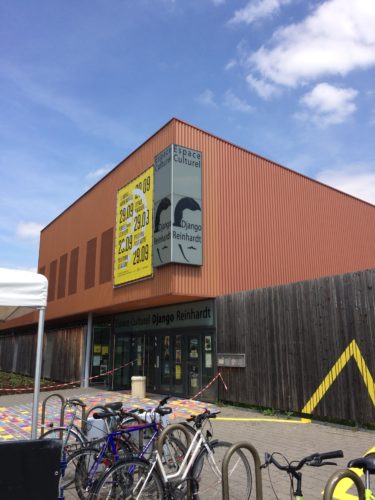
Photo gallery 2.3: Neuhof Music School end-of-year concert, 2018
Click on the images below to enlarge. Click "image descriptions" under the gallery for more information.
- 2.3.1 - Audience looking on at performers. Source: Facebook.
- 2.3.2 - Le C(h)œur des femmes. Photo by Siv B. Lie.
- 2.3.3 - Saz students. Photo by Siv B. Lie.
- 2.3.4 - Flamenco students. Photo by Siv B. Lie.
- 2.3.5 - Flamenco students. Source: Facebook.
- 2.3.6 - Francko Mehrstein and guitar students. Source: Facebook.
- 2.3.7 - Neuhof Music School director Laetitia Quieti delivering announcements. Photo by Siv B. Lie.
- 2.3.8 - Mandino Reinhardt and guitar students. Photo by Siv B. Lie.
- 2.3.9 - Mandino Reinhardt and guitar students. Source: Facebook.
